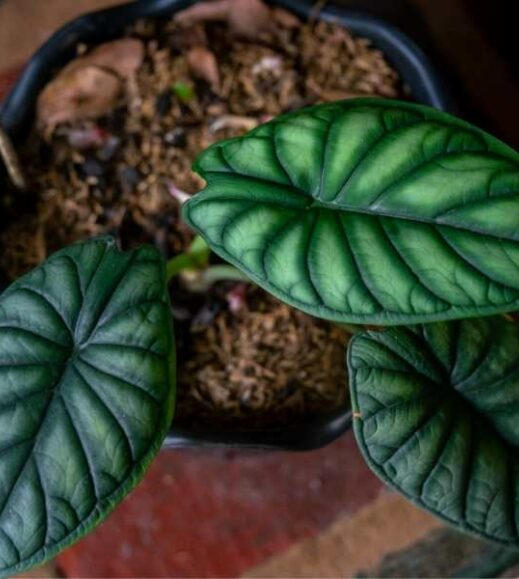Propagate | Soil | Light | Water | Temperature | Humidity | Potting | Pruning | Fertilize | Pest Control | FAQs
Alocasia dragon scale plants are native to Asia's tropical and subtropical regions. They belong to the Araceae family, which includes several popular houseplants like peace lilies (Spathiphyllum spp.). Alocasia dragon scale plants have large glossy green leaves that are heavily veined and held on long, robust stems. The leaves are arranged in an exemplary fashion and have a distinctively scaly texture, hence the name dragon scale.
Caring for Alocasia dragon scale plants can be easy if you know what to look for. This guide will answer all your questions about growing and caring for Alocasia dragon-scale plants. We'll cover topics such as the ideal growing environment, soil requirements, watering and fertilizing needs, and potential pests or disease problems.
Do Alocasia dragon scale flower? What color is the Alocasia dragon scale flower?
The Alocasia dragon scale plant rarely flowers, but when it does, the flower is white. The flower has a yellow center and can last up to two weeks. Unfortunately, the blooms are usually not showy enough to be noticed by gardeners.
When to plant Alocasia dragon scale plant?
Alocasia dragon scale plants are best planted in the spring when the soil is moist and temperatures are consistent. Plant your Alocasia dragon scale in a pot with well-draining soil and place it in a bright, indirect location.
Alocasia dragon scale soil requirements: What is the best soil for the Alocasia dragon scale plants?
Alocasia dragon scale plants prefer soil that is well-draining and rich in organic matter. A good potting mix will provide the necessary drainage, aeration, and nutrients for your Alocasia dragon scale plants. Be sure to avoid soil that is too soggy or waterlogged, as this can lead to root rot.
Adding amendments and enhancers can also benefit your Alocasia dragon scale plants. Adding compost, aged manure, or worm castings can help to improve the soil's fertility and texture. Perlite or pumice can also be added to the soil to improve drainage, aeration, and moisture retention.
Alocasia dragon scale light requirements: How much light does Alocasia dragon scale plant need?
Alocasia dragon scale plants prefer bright, indirect light but can also tolerate lower light conditions. Avoid direct sunlight, as this can scorch the leaves. If you notice the leaves drooping, this could be a sign that the plant needs more light.
Plant grow light can also be used to supplement sunlight if your Alocasia dragon scale is not receiving enough light. These lights are designed to give plants the exact wavelengths they need to thrive.
Alocasia dragon scale water requirements: How often to water the Alocasia dragon scale plant?
Alocasia dragon scale plants need to be watered regularly, but they should never be left to sit in water. The soil should remain slightly moist but never soggy. To test the soil, stick your finger into the soil up to the first knuckle. If it feels dry, it is time to water. However, overwatering can lead to root rot and other diseases, so it's important to be careful with your watering schedule.
An irrigation system can be used to ensure your Alocasia dragon scale plant gets the right amount of water. This can be especially helpful if you're worried about overwatering your plant.
Alocasia dragon scale temperature range: What temperature can Alocasia dragon scale tolerate?
Alocasia dragon scale plants prefer temperatures between 65-75 degrees Fahrenheit. They can tolerate higher temperatures for short periods if not kept in direct sunlight. Protect your Alocasia dragon scale plants from draughts and cold winds, as these can damage the leaves.
To protect plants during bad weather, you can use a greenhouse, cold frame, and plant protective covers to shield plants from extreme temperatures.
Alocasia dragon scale humidity: Do Alocasia dragon scale like humidity?
Alocasia dragon scale plants prefer high humidity, so it's important to maintain a level of humidity that is comfortable for the plant. You can use a humidifier to raise the humidity levels in your home, or you can regularly mist the leaves of your Alocasia dragon scale plants.
You can also use a tray filled with gravel and water to help increase humidity. Ensure the potting mix for your Alocasia dragon scale plant is allowed to dry out completely between waterings.
You can use a humidity dome to maintain the humidity of plants around your Alocasia dragon scale maintain the humidity of plants around your Alocasia dragon scale; you can use a humidity dome. This plastic dome fits over the plants and will help provide them with additional humidity.
Alocasia dragon scale plant propagation: How to propagate Alocasia dragon scale plant?
Several methods of propagating plants include division, stem cuttings, and leaf cuttings. For Alocasia dragon scale plants, the most popular method is division.
Propagating Alocasia dragon scale plant by stem cutting
Alocasia dragon scale plants can also be propagated from stem cuttings. Take a cutting of about 4-6 inches long and remove all but the top two leaves. Dip the end of the stem in rooting hormone and plant it in moist soil.
Place the pot with the cutting in a warm location with indirect light and mist the soil regularly. The stem should root in 4-6 weeks. Once it has rooted, you can transplant it into a larger pot.
Propagating Alocasia dragon scale plant by leaf cutting
You can also propagate Alocasia dragon scale plants from leaf cuttings. Cut a mature leaf from the plant into smaller pieces with 3-4 leaves each. Dip the end of the cutting into the rooting hormone and plant it in moist soil. Place the cuttings in a warm, humid environment and cover them with transparent plastic or glass to maintain the humidity. Keep your soil moist but not soggy, and wait for roots to develop.
Propagating Alocasia dragon scale plant by division
Alocasia dragon scale plants can also be propagated by division. Start by carefully removing the plant from its pot and gently separating the roots with your hands. Once the plant is divided, repot it into a new pot or container filled with fresh soil.
Water your newly planted Alocasia dragon scale plants well and place them in a warm location away from direct sunlight. Keep the soil evenly moist but not soggy, and fertilize monthly with liquid fertilizer.
Potting Alocasia dragon scale plant
Alocasia dragon scale plants should be planted in a well-draining potting mix. You can add perlite or pumice to the soil mix to help drainage. A container with a wide base and drain holes at the bottom is ideal for Alocasia dragon scale plants. Make sure to choose a pot slightly larger than your plant's size to accommodate growth.
It is important to select the correct pot size or container for your Alocasia dragon scale plant. If the pot is too small, it can impede growth and cause stunting. If the pot is too large, the soil may become waterlogged, and the plant can suffer from root rot.
How to prune Alocasia dragon scale plant?
Pruning is an important part of caring for Alocasia dragon scale plants. Pruning helps to encourage healthy growth, remove dead or dying leaves, and promote bushier growth. Prune your Alocasia dragon scale plants by gently pinching off the tips of the stems and leaves with your fingers or scissors.
The leaves of Alocasia dragon scale plants are susceptible to pests and diseases. The most common pests include mealybugs, aphids, spider mites, and fungus gnats. To treat these pests, use a natural insecticide such as neem oil or insecticidal soap.
To prevent pests and diseases from occurring, keep your Alocasia dragon scale plants in a clean environment, away from other plants that may harbor pests or diseases. Make sure to inspect your plants regularly and remove any dead or dying leaves as soon as possible.
How to fertilize Alocasia dragon scale plant?
Fertilizing your Alocasia dragon scale plants helps to promote healthy growth and increase the number of flowers. Fertilize your plants monthly with a balanced fertilizer such as 10-10-10 or organic fertilizer. Apply the fertilizer to the soil around the base of the plant and water it in a well.
Choose a high-quality fertilizer to fertilize your Alocasia dragon scale. Some plants benefit by adding appropriate soil amendments.
Common Alocasia dragon scale diseases and how to manage Alocasia dragon scale disease?
Alocasia dragon scale plant is prone to a few common pests and diseases, including:
- Fungal diseases: Powdery mildew and root rot can cause yellowing, wilting, and stunted growth. Water your plants properly and use a fungicide to prevent these fungal diseases.
- Viral diseases: Alocasia dragon scale plants can also suffer from viral diseases such as mosaic virus and leaf curl. To prevent these diseases, inspect your plant regularly and isolate any plants that show signs of infection.
- Bacterial diseases: Bacterial leaf spots and bacterial blight can cause yellowing, wilting, and stunted growth. To prevent these bacterial diseases, make sure to keep your plants in a clean environment and use an appropriate pesticide or fungicide.
In case of an outbreak, Use good quality insecticides and fungicides to treat the infected areas. Always follow the instructions carefully to avoid damaging or harming your plants.
Ten reasons to grow Alocasia dragon scale
1. Versatile and Attractive: Alocasia dragon scale plants are versatile and attractive, making them a great addition to any garden.
2. Easy to Care: Alocasia dragon scale plants are easy to care for and require minimal maintenance.
3. Low Maintenance: Alocasia dragon scale plants require little pruning or fertilization, making them low-maintenance houseplants.
4. Long Life Span: Alocasia dragon scale plants can live up to 10 years if properly cared for.
5. Native To Tropical Climates: Alocasia dragon scale is native to tropical climates and loves humid environments, making it perfect for indoor gardening in temperate climates.
6. Eye-Catching Foliage: Alocasia dragon scale has unique and eye-catching foliage that stands out in any garden.
7. Heat Tolerant: Alocasia dragon scale is heat tolerant, making it a great choice for gardeners in warmer climates.
8. Disease Resistant: Alocasia dragon scale plants are resistant to common diseases, making them easy to care for and maintain.
9. Attracts Beneficial Insects: The flowers of the Alocasia dragon scale attract beneficial insects such as bees and butterflies, which help pollinate your garden plants.
10. Great For Small Spaces: Alocasia dragon scale can be grown in large and small gardens or containers, making them an ideal choice for gardeners with limited space.
Conclusion
Alocasia dragon scale plants are easy to care for and require minimal maintenance, making them a great choice for beginner and experienced gardeners. They are heat-tolerant and disease resistant, meaning they can thrive in warmer climates. Plus, the unique foliage of the Alocasia dragon scale is sure to stand out in any garden! If you're looking for a low-maintenance houseplant that will provide color and life to your home or garden, then the Alocasia dragon scale may be just the plant for you.
Explore our plant grow and care guides collection if you want to add some more plants to your garden.
If you're new to gardening or a seasoned pro, join our supportive AgFunnel community of gardeners. Share a picture of your garden and receive support from fellow plant lovers. Happy gardening.
FAQs
What is Alocasia dragon scale?
Alocasia dragon scale is a tropical plant native to Southeast Asia. It has deep green leaves with silver-gray markings, giving it a unique and eye-catching appearance. Alocasia dragon scale is easy to care for and requires minimal maintenance, making it a great choice for beginner and experienced gardeners.
Where to put Alocasia dragon scale?
Alocasia dragon scale is best suited for warm, humid conditions in partial shade. They thrive when planted indoors near a large window or in a conservatory.
How often should Alocasia dragon scale be watered?
Alocasia dragon scale should be watered regularly and kept moist but not soggy. Water your plant when the top inch of soil is dry, and avoid overwatering to prevent root rot. You can also mist the leaves of your plant periodically for additional humidity.
How to get Alocasia dragon scale to bloom?
Alocasia dragon scale plants rarely bloom indoors. To get your plant to bloom, you need to provide it with the right environmental conditions, such as high humidity and temperatures from 60 to 80 degrees Fahrenheit (16-27 Celsius). It also needs a lot of light, so place it near a bright window or under a grow light.
Does Alocasia dragon scale plant like sun or shade?
Alocasia dragon scale thrives in partial shade or indirect light. Too much direct sunlight can damage the foliage and cause sunburns, so avoid placing your plant in direct sunlight.
Is the Alocasia dragon scale plant annual or perennial?
Alocasia dragon scale is a perennial plant, meaning it will come back year after year with the correct care. With the right conditions, it can live for many years.
Does the Alocasia dragon scale plant come back every year?
Yes, with the right care and environmental conditions, the Alocasia dragon scale will come back every year. Ensure your plant has adequate light, water, and humidity for the best results.
Are Alocasia dragon scale plants toxic to cats?
Yes, Alocasia dragon scale plants are toxic to cats. The leaves contain oxalic acid, which can be harmful if ingested by cats or other animals. If you have cats in your home, keeping them away from this plant is best.
Are Alocasia dragon scale plants toxic to dogs?
Yes, Alocasia dragon scale plants are toxic to dogs. The leaves contain oxalic acid, which can be harmful if ingested by dogs or other animals. If you have dogs in your home, keeping them away from this plant is best.
Are Alocasia dragon scale plants toxic to pets?
Yes, Alocasia dragon scale plants are toxic to pets. The leaves contain oxalic acid, which can be harmful if ingested by cats, dogs, or other animals. If you have pets in your home, keeping them away from this plant is best.
How cold can Alocasia dragon scale plants tolerate?
Alocasia dragon scale plants prefer warm temperatures between 60 and 80 degrees Fahrenheit (16-27 Celsius). The leaves will turn yellow if exposed to cold temperatures, and the plant may not survive. If you live in a colder climate, bring your Alocasia dragon scale indoors during winter.
How often to water the Alocasia dragon scale plant?
Alocasia dragon scale should be watered regularly and kept moist but not soggy. Water your plant when the top inch of soil is dry, and avoid overwatering to prevent root rot. You can also mist the leaves of your plant periodically for additional humidity.
What are the Differences in Care Between Alocasia Dragon Scale and Alocasia Tiny Dancer Plants?
When it comes to growing Alocasia plants, the care for Alocasia Dragon Scale and Alocasia Tiny Dancer differs slightly. Alocasia Dragon Scale prefers more indirect light and a well-draining soil mix, while Alocasia Tiny Dancer thrives in bright, indirect light and consistently moist soil. Understanding these variations is important for successfully growing Alocasia Tiny Dancer plant.
When to stop watering the Alocasia dragon scale plant?
Stop watering the Alocasia dragon scale plant when the top inch of soil is dry.

How to master gardening? Download these essential home and gardening ebooks today!


















